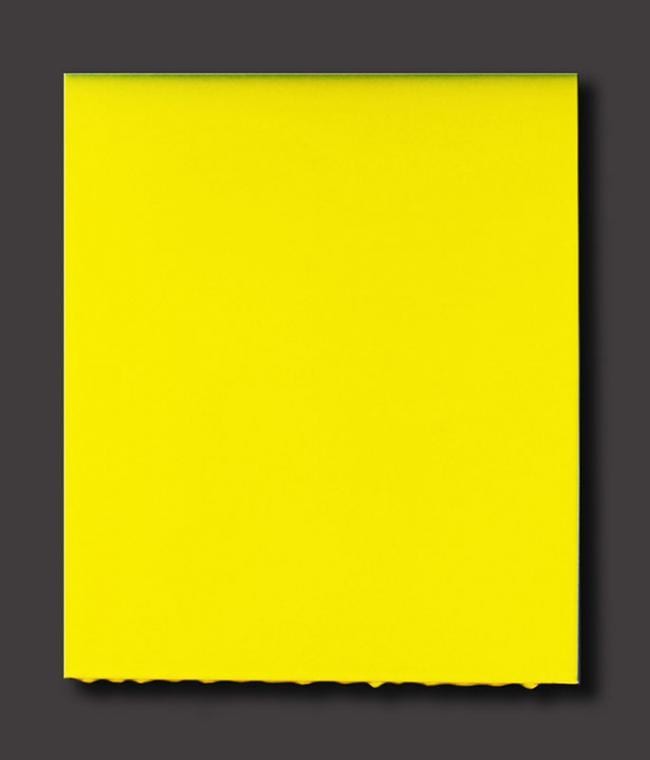Bobby Silverman is showing new work at the core of his artistic and design practice. Art and Industry at The Clay Studio (Philadelphia October 3 – November 30, 2014) is Silverman’s most extensive exhibition to date. The show reflects the diverse range of his interests in industrial materials and processes.
Above image: Bobby Silverman, Untitled, 2014, commercial porcelain, 22 x 19 inches, $2,800
Silverman’s work has evolved over the last 30 years from his early apprenticeship under the master potter Samejima Sataro in Japan, to his recent line of industrially-produced architectural tiles, to his large format conceptual ceramic pieces. His work is also informed by his early training as a social geographer and his interest in the visualization of data.
Silverman has a passionate commitment to the idiosyncratic nature of ceramic material, particularly the phenomenological properties of gravity, luminosity, reflection and translucency. His commercially manufactured ceramic tiles for his company Alsio Design combine the reflective properties of ceramic and metallic surfaces with topographical forms that are created by 3D modeling programs. Silverman’s designs produce vibrant and compelling patterns that are in demand for both high-end residential and commercial applications. It makes sense showing both art and design together on this one occasion but would not be a useful device in the future.

Bobby Silverman, Ponty #2, 2014, commercial porcelain, 35 x 27.5 inches, $6,000
It coincides with DesignPhiladelphia, a signature event of the Philadelphia Center for Architecture. It is the oldest and largest design event of its kind in the country and annually showcases the work of over 400 practicing architects, designers, and creative professionals
Bobby Silverman’s current two-dimensional work has as much to do with ideas about contemporary painting as it does with traditional ceramic practice. His exploration of language and how we understand the world around us is the basis of the work exhibited in Art and Industry. His pieces contain elements of text and quotes by artists and philosophers, particularly those of Maurice Merleau-Ponty, a phenomenologist Silverman much admires. Merleau-Ponty believed that the body, as well as the mind, is key to understanding the world. The haptic sensibilities of clay provide a perfect complement to the cognitive process.

Bobby Silverman, Wilde, 2014, commercial porcelain, glaze, 35 x 27.5 inches, $6,000
Much of the text in Silverman’s large tiles is in the form of Morse code, Braille, barcode and other systems of meaning which recede into layers of pattern and resist simple interpretation by the viewer. Recent work contains texts in English which are somewhat obscured by the high-temperature firings that blur both form and meaning. He believes the work, which is simultaneously narrative and decorative, provides a fascinating opportunity for semiotic exploration: where semantic interchange is impossible, the beauty of the symbolic language takes precedent.
Bobby Silverman’s work is in the permanent collections of the Museum of Contemporary Art and Design, New York City; the European Ceramic Work Center, s’Hertogenbosch, The Netherlands; the Mint Museum, Charlotte, NC; and the Renwick Gallery, Smithsonian American Art Museum, Washington D.C.

Bobby Silverman, Motherwellm 2013, commercial porcelain, glaze, 36 x 28 inches, $6,000
Silverman has received fellowships from the National Endowment for the Arts, the New York State Council for the Arts, and the Louisiana State Council for the Arts. He has taught and lectured in China, Europe, the Middle East, and the U.S. In 2007 he formed the company Alsio Design which designs, manufactures and distributes ceramic tile.
Any thoughts about this post? Share yours in the comment box below.

Bobby Silverman, Untitled, 2014, commercial porcelain, 22 x 19 inches, $2,800

Bobby Silverman, Untitled, 2014, porcelain, glaze, 35 x 56 inches, $12,000

Alsio Design’s “Linea Collection” in matt white, 11.8 x 11.8-inch glazed ceramic tile, 2013

Alsio Design “Diamante” (left) and “Versaillies” glazed ceramic tile collections, 2012, 11.8 x 11.8 inches

Alsio Design’s “Versailles” tile collections in white and silver, 2012

Alsio Design “Diamante” glazed ceramic tile collections in black and gold, 2012.

Alsio Design “Versailles Collection” in black, 2014, 11.8 x 11.8 inches, glazed ceramic tile for Design Hotel Lobby in Foshan, China.

Installation view.

Add your valued opinion to this post.